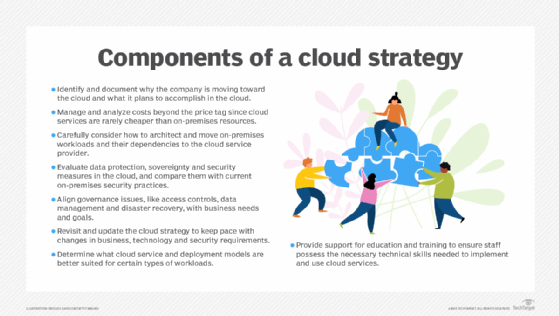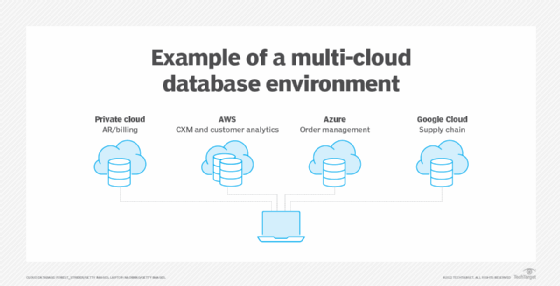What is multi-cloud? Definition, pros and cons
Multi-cloud is an approach to cloud computing that involves combining two or more cloud services from different providers. A multi-cloud architecture can be customized to suit an organization's technical and business goals. They also provide flexibility, scalability and other advantages such as preventing vendor lock-in.
Multi-cloud environments provide organizations with more flexibility in terms of features and price than they would get with a single cloud service. Customers can choose the speed, capacity and other features that a cloud provider in a particular geographic region offers. Enterprises are far more likely to adopt this approach than small and midsize businesses because upfront costs can be high and management or monitoring multiple clouds is challenging.
When should a business adopt multi-cloud?
Organizations making the switch from a single cloud provider to a multi-cloud approach often do so to increase the reliability and security of their cloud infrastructure. With alternative cloud services available, multi-cloud prevents data loss or downtime if one cloud platform has an outage. The multi-cloud approach also helps organizations avoid vendor lock-in.
In addition, some organizations pursue multi-cloud deployments for data sovereignty reasons. Certain laws, regulations and company policies require enterprise data to physically reside in specific locations. With more than one cloud service, organizations can select from multiple infrastructure-as-a-service providers' data center regions or availability zones. This flexibility in where cloud data resides also enables organizations to locate their compute resources as close as possible to end users to optimize performance and minimize latency.
This article is part of
What is cloud management? Definition, benefits and guide
Business use cases for multi-cloud
There are multiple business use cases for a multi-cloud architecture, including the following:
- Edge computing. A multi-cloud strategy is useful for edge technology, such as internet of things devices. Having multiple cloud services that are closer to data-gathering devices lets a business collect and process data in real time.
- Supporting remote workforces. Organizations with employees in different countries are able to use a cloud infrastructure and service that are geographically closer to them, enhancing performance and reducing latency.
- Containerized software applications. Software built by combining multiple modules or components, called containers, is often deployed in multiple clouds simultaneously using platforms such as Kubernetes.
- Migrating workloads to the cloud. It's common for companies to migrate a traditional, on-premises IT infrastructure to a multi-cloud environment to comply with data security and privacy laws.

Benefits of a multi-cloud strategy
A multi-cloud strategy has several advantages, such as the following:
- Customizable solutions. An organization chooses different clouds from different providers that are best suited to handle the tasks they need. This freedom to customize, in turn, improves performance.
- Flexibility. A multi-cloud approach lets organization avoid vendor lock-in and not become reliant on a single vendor for everything.
- Disaster recovery. Events such as power outages can cause downtime and lead to data loss and other issues. Having multiple clouds means if one cloud goes offline, others are available to ensure business continuity.
- Compliance. Having multiple cloud providers means an organization is likely to have a provider that complies with a specific country's laws and regulations.
- Cost savings. Multi-cloud lets an organization compare prices and features of different cloud offerings to find the least expensive options with the features they need.
Challenges of a multi-cloud strategy
Multi-cloud approaches have several potential drawbacks:
- Upfront costs. Most providers offer volume discounts for public clouds, where prices are reduced as customers buy more of a particular service. It can be difficult for an organization to qualify for those discounts when it doesn't concentrate its business with a single cloud provider.
- Qualified staff. A multi-cloud environment requires an IT staff to have multiple kinds of cloud platform or provider expertise. A lack of expertise might require organizations to hire new IT experts.
- Monitoring and management. Monitoring and managing the performance of each cloud platform within a multi-cloud environment is difficult. A centralized dashboard can provide visibility but might have to be customized.
- Security. Many clouds in an environment means an increased likelihood of cyberattacks with larger attack surfaces for malicious actors.
- Long-distance latency issues. Different clouds in different geographic locations might experience downtime and go offline, plus latency issues might hinder data transfers from one cloud to another over great distances.
Best practices for multi-cloud adoption and management
There is no single correct way to implement and manage a multi-cloud environment. However, there are steps an organization can take to ensure such an environment is built to last:
- Goal setting. Defining goals and issues with existing IT infrastructure is crucial to justify purchasing products from cloud providers. This planning stage should determine metrics for measuring success.
- Tool selection. A multi-cloud approach also offers the ability to select different cloud services from different providers. For example, one cloud platform might handle large numbers of requests in a certain time frame, while a different cloud platform might perform better for a smaller number of requests in the same time frame. Some cloud providers also offer more big data analytics tools or other specialized capabilities, such as machine learning, than their competitors.
- Security and compliance. Once the needed tools are implemented, an organization should codify security policies for employees to follow. Other security measures, such as encryption and multifactor authentication, should be used as well, depending on laws and regulations applying to the organization.
- Management. Experienced IT staff members are necessary for working with multi-cloud environments. In the case of new tools, training is needed to bring staff up to speed.
- Continuous oversight. The final step is to continuously monitor the performance of a multi-cloud environment after it is implemented.
What is the difference between multi-cloud and hybrid cloud?
Multi-cloud and hybrid cloud computing are similar but different IT infrastructure models.
Hybrid cloud refers to a cloud computing environment that uses a mix of on-premises private clouds and third-party public clouds, with orchestration between the two. An enterprise often adopts hybrid cloud to achieve a specific task, such as to run workloads in-house, and then burst into the public cloud when compute demands spike.
Multi-cloud computing commonly refers to the use of multiple public or private cloud providers. It's a general approach to managing and paying for cloud services in the way that seems best for a given organization.
However, multi-cloud doesn't preclude hybrid cloud, and a hybrid cloud could be part of a multi-cloud deployment. The two models are not mutually exclusive; their use depends on what a business hopes to achieve.
What types of multi-cloud services do cloud vendors offer?
A multi-cloud strategy involves a mix of services from public cloud providers, such as Amazon Web Services (AWS), Google, Microsoft and IBM. The types of multi-cloud services they offer include the following:
- Data. Cloud providers offer data storage, protection, analytics and other features that work within multi-cloud environments.
- Security. Security in multi-cloud implementations is challenging. Providers have centralized security management tools available, such as the AWS Security Hub offering.
- Management. Platforms such as Microsoft Azure Arc help provide one interface to let IT teams manage resources spread over multiple cloud computing environments through a single interface. Meanwhile, orchestration platforms such as Kubernetes manage containerized software apps.
- Networking. Connectivity is important when working across disparate cloud environments. Providers such as Cisco and VMware offer multi-cloud networking capabilities.

Visibility into the performance of multiple clouds is difficult to achieve and requires tailored tools and strategies to do so. Learn tips to achieve multi-cloud visibility.





